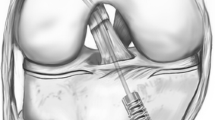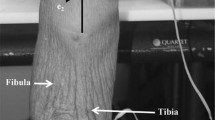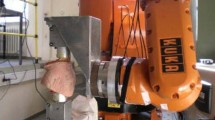Abstract
Purpose
Double-bundle anterior cruciate reconstructions have led to an increased interest in quantifying anterolateral rotatory stability. The application of combined internal rotation and valgus torques to the knee can more nearly recreate the anterolateral subluxation that occurs in the pivot shift test in vitro compared to coupled internal rotation torque and anterior tibial loads.
Methods
Twelve non-paired cadaveric knees were biomechanically tested with the ACL intact and sectioned. For each test state, six-degree-of-freedom positional data were collected for two simulated pivot shift loads consisting of a 5-Nm internal rotation torque coupled with either a 10-Nm valgus torque or an 88 N anterior tibial load at 0°, 20°, 30°, 60°, and 90° of knee flexion.
Results
The coupled internal rotation and valgus torques produced a significant increase in anterolateral subluxation between the ACL intact and sectioned states at all tested angles except 90º (5.9 ± 0.4 mm at 0°, 4.3 ± 0.6 mm at 20°, 3.5 ± 0.6 mm at 30°, 2.1 ± 0.6 mm at 60°). The coupled internal rotation and an anterior tibial load produced significant increases between the ACL intact and sectioned states at all tested angles except 30º (5.4 ± 0.5 mm at 0°, 3.7 ± 0.5 mm at 20°, 2.1 ± 0.8 mm at 60°, 1.4 ± 0.3 mm at 90°).
Conclusions
We found that the coupled internal rotation and valgus torques best recreated the anterolateral subluxation that occurs in the pivot shift in vitro. This study describes an anterolateral subluxation test for ACL integrity in the laboratory setting.



Similar content being viewed by others
References
An KN, Jacobsen MC, Berglund LJ, Chao EY (1988) Application of a magnetic tracking device to kinesiologic studies. J Biomech 21:613–620
Anderson CJ, Westerhaus BD, Pietrini SD, Ziegler CG, Wijdicks CA, Johansen S, Engebretsen L, Laprade RF (2010) Kinematic impact of anteromedial and posterolateral bundle graft fixation angles on double-bundle anterior cruciate ligament reconstructions. Am J Sports Med 38:1575–1583
Bach BR Jr, Warren RF, Wickiewicz TL (1988) The pivot shift phenomenon: results and description of a modified clinical test for anterior cruciate ligament insufficiency. Am J Sports Med 16:571–576
Bull AM, Andersen HN, Basso O, Targett J, Amis AA (1999) Incidence and mechanism of the pivot shift. An in vitro study. Clin Orthop Relat Res 363:219–231
Coobs BR, LaPrade RF, Griffith CJ, Nelson BJ (2007) Biomechanical analysis of an isolated fibular (lateral) collateral ligament reconstruction using an autogenous semitendinosus graft. Am J Sports Med 35:1521–1527
Coobs BR, Wijdicks CA, Armitage BM, Spiridonov SI, Westerhaus BD, Johansen S, Engebretsen L, Laprade RF (2010) An in vitro analysis of an anatomical medial knee reconstruction. Am J Sports Med 38:339–347
Debandi A, Maeyama A, Lu S, Hume C, Asai S, Goto B, Hoshino Y, Smolinski P, Fu FH (2011) Biomechanical comparison of three anatomic acl reconstructions in a porcine model. Knee Surg Sports Traumatol Arthrosc 19:728–735
Diermann N, Schumacher T, Schanz S, Raschke MJ, Petersen W, Zantop T (2009) Rotational instability of the knee: internal tibial rotation under a simulated pivot shift test. Arch Orthopaedic Trauma Surg 129:353–358
Galway HR, MacIntosh DL (1980) The lateral pivot shift: a symptom and sign of anterior cruciate ligament insufficiency. Clin Orthop Relat Res 147:45–50
Griffith CJ, LaPrade RF, Johansen S, Armitage B, Wijdicks C, Engebretsen L (2009) Medial knee injury: Part 1, static function of the individual components of the main medial knee structures. Am J Sports Med 37:1762–1770
Hassler H, Jakob RP (1981) on the cause of the anterolateral instability of the knee joint. A study on 20 cadaver knee joints with special regard to the tractus iliotibialis (author’s transl). Arch Orthop Trauma Surg 98:45–50
Hughston JC, Andrews JR, Cross MJ, Moschi A (1976) Classification of knee ligament instabilities. Part I. The medial compartment and cruciate ligaments. J Bone Jt Surg Am 58:159–172
Kanamori A, Zeminski J, Rudy TW, Li G, Fu FH, Woo SL (2002) The effect of axial tibial torque on the function of the anterior cruciate ligament: a biomechanical study of a simulated pivot shift test. Arthroscopy 18:394–398
Kocher MS, Steadman JR, Briggs KK, Sterett WI, Hawkins RJ (2004) Relationships between objective assessment of ligament stability and subjective assessment of symptoms and function after anterior cruciate ligament reconstruction. Am J Sports Med 32:629–634
Kondo E, Merican AM, Yasuda K, Amis AA (2010) Biomechanical comparisons of knee stability after anterior cruciate ligament reconstruction between 2 clinically available transtibial procedures: anatomic double bundle versus single bundle. Am J Sports Med 38:1349–1358
Lie DT, Bull AM, Amis AA (2007) Persistence of the mini pivot shift after anatomically placed anterior cruciate ligament reconstruction. Clin Orthop Relat Res 457:203–209
Liu SH, Osti L, Henry M, Bocchi L (1995) The diagnosis of acute complete tears of the anterior cruciate ligament. Comparison of mri, arthrometry and clinical examination. J Bone Jt Surg Br 77:586–588
Losee RE, Johnson TR, Southwick WO (1978) Anterior subluxation of the lateral tibial plateau. A diagnostic test and operative repair. J Bone Jt Surg Am 60:1015–1030
Maeyama A, Hoshino Y, Debandi A, Kato Y, Saeki K, Asai S, Goto B, Smolinski P, Fu FH (2011) Evaluation of rotational instability in the anterior cruciate ligament deficient knee using triaxial accelerometer: a biomechanical model in porcine knees. Knee Surg Sports Traumatol Arthrosc 19:1233–1238
Markolf KL, Jackson SR, McAllister DR (2010) A comparison of 11 o’clock versus oblique femoral tunnels in the anterior cruciate ligament-reconstructed knee: knee kinematics during a simulated pivot test. Am J Sports Med 38:912–917
Markolf KL, Jackson SR, McAllister DR (2010) Relationship between the pivot shift and lachman tests: a cadaver study. J Bone Jt Surg Am 92:2067–2075
Milne AD, Chess DG, Johnson JA, King GJ (1996) Accuracy of an electromagnetic tracking device: a study of the optimal range and metal interference. J Biomech 29:791–793
Petersen W, Tretow H, Weimann A, Herbort M, Fu FH, Raschke M, Zantop T (2007) Biomechanical evaluation of two techniques for double-bundle anterior cruciate ligament reconstruction: one tibial tunnel versus two tibial tunnels. Am J Sports Med 35:228–234
Slocum DB, James SL, Larson RL, Singer KM (1976) Clinical test for anterolateral rotary instability of the knee. Clin Orthop Relat Res 118:63–69
Slocum DB, Larson RL (1968) Rotatory instability of the knee. Its pathogenesis and a clinical test to demonstrate its presence. J Bone Jt Surg Am 50:211–225
Tsai AG, Wijdicks CA, Walsh MP, Laprade RF (2010) Comparative kinematic evaluation of all-inside single-bundle and double-bundle anterior cruciate ligament reconstruction: a biomechanical study. Am J Sports Med 38:263–272
Xu Y, Liu J, Kramer S, Martins C, Kato Y, Linde-Rosen M, Smolinski P, Fu FH (2011) Comparison of in situ forces and knee kinematics in anteromedial and high anteromedial bundle augmentation for partially ruptured anterior cruciate ligament. Am J Sports Med 39:272–278
Yagi M, Wong EK, Kanamori A, Debski RE, Fu FH, Woo SL (2002) Biomechanical analysis of an anatomic anterior cruciate ligament reconstruction. Am J Sports Med 30:660–666
Yamamoto Y, Hsu WH, Fisk JA, Van Scyoc AH, Miura K, Woo SL (2006) Effect of the iliotibial band on knee biomechanics during a simulated pivot shift test. J Orthop Res 24:967–973
Zantop T, Schumacher T, Schanz S, Raschke MJ, Petersen W (2010) Double-bundle reconstruction cannot restore intact knee kinematics in the acl/lcl-deficient knee. Arch Orthop Trauma Surg 130:1019–1026
Acknowledgments
Funding for this study was provided by the Health South-East of Norway Grant #2009064. We would also like to thank Conrad Lindquist, and Steinar Johansen MD for their contributions.
Author information
Authors and Affiliations
Corresponding author
Rights and permissions
About this article
Cite this article
Engebretsen, L., Wijdicks, C.A., Anderson, C.J. et al. Evaluation of a simulated pivot shift test: a biomechanical study. Knee Surg Sports Traumatol Arthrosc 20, 698–702 (2012). https://doi.org/10.1007/s00167-011-1744-1
Received:
Accepted:
Published:
Issue Date:
DOI: https://doi.org/10.1007/s00167-011-1744-1




